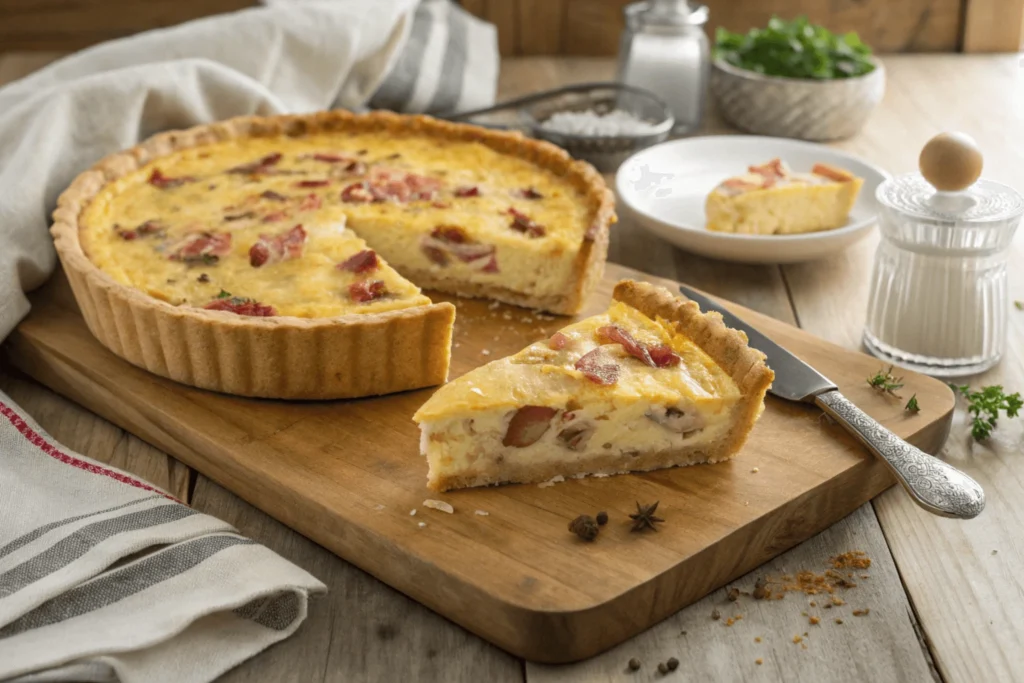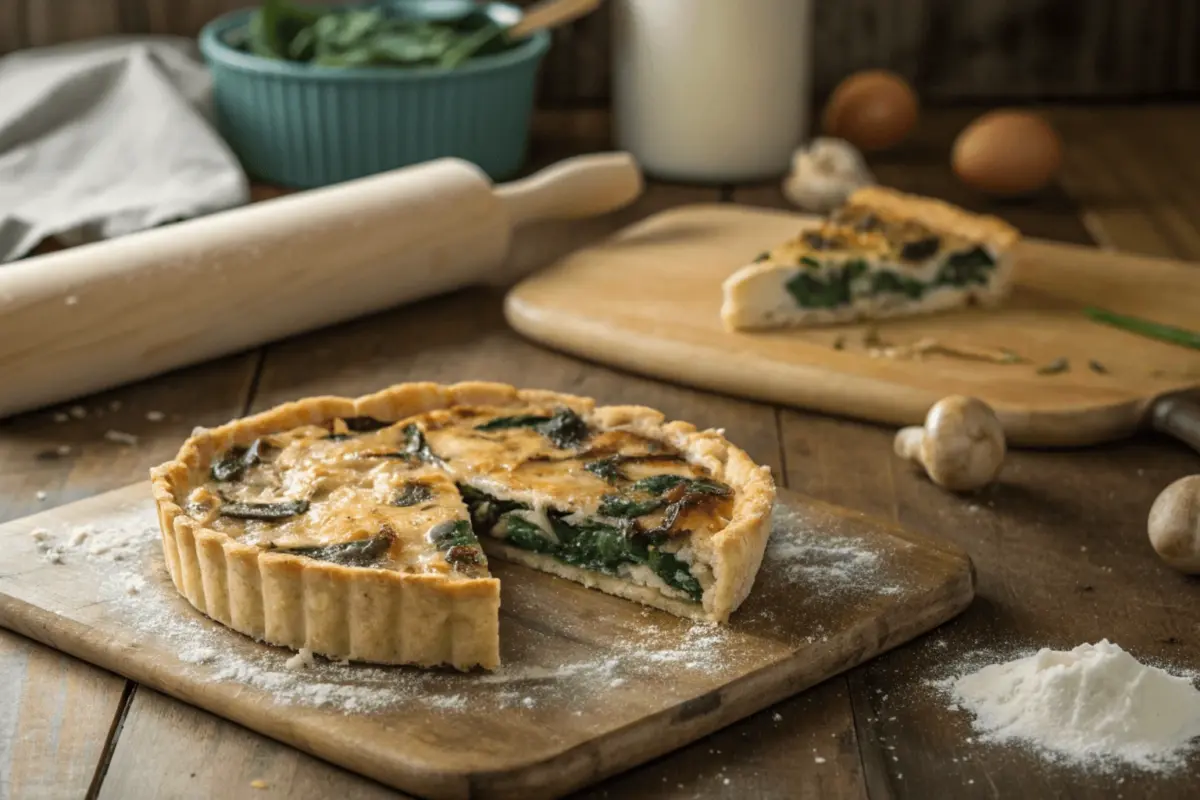Introduction
Let’s settle the debate—does quiche crust need to be pre-baked or not? If you’ve ever wondered why your quiche crust turns out soggy or how to get that golden, flaky texture, you’re not alone. The answer isn’t always cut and dry, but don’t worry, I’ve got your back! In this guide, we’ll cover everything you need to know about quiche crusts—from pre-baking techniques to expert tips. Whether you’re making a classic quiche Lorraine or experimenting with vegetarian fillings, the crust can make or break your dish. Some bakers swear by pre-baking to avoid a soggy bottom, while others prefer shortcuts that save time without sacrificing flavor. By the end of this guide, you’ll have a clear answer to the question: does quiche crust need to be pre-baked?
Understanding Quiche and Its Components
What Is Quiche?
Quiche is a savory pie that features a custardy filling made of eggs, cream, and a variety of mix-ins like bacon, vegetables, or cheese. Its origins trace back to France, where quiche has become a symbol of refined comfort food. What makes a quiche truly shine, however, is the crust. A perfect crust is golden, flaky, and sturdy enough to support the rich filling without becoming soggy. While traditional pastry crusts are a staple, some modern takes, such as the Tortilla Quiche Bake, offer innovative twists by replacing classic crusts with tortillas for a lighter, crispier base. Experimenting with these variations can elevate your quiche to new culinary heights.
The Role of the Crust in Quiche
The crust is the unsung hero of quiche. A well-made crust holds everything together and adds a satisfying crunch. If the crust isn’t baked correctly, it can turn soggy—nobody wants that! For beginners, considering crust alternatives, like tortillas, is worth exploring. Learn more about it in Can I Use Tortillas Instead of Pastry?.
Why Pre-Baking Is Debated
Advantages of Pre-Baking a Quiche Crust
Let’s start with the pros. Pre-baking, or “blind baking,” gives your crust a head start in the oven. This helps prevent it from getting soggy once the eggy filling goes in. Plus, it ensures your crust is evenly baked and crispy, which is a win for anyone who loves a perfect bite every time.
Disadvantages of Pre-Baking
Now, on the flip side, pre-baking isn’t without its downsides. For one, it adds an extra step to your baking process. (Hello, busy schedules!) It also requires a few extra tools, like pie weights or dried beans, which can be annoying if you don’t already have them on hand. And let’s be honest—sometimes you just want to toss everything together and bake without the fuss.
Techniques for Pre-Baking Quiche Crust
Blind Baking: The Traditional Method
Blind baking is the go-to method when you’re serious about avoiding a soggy crust. This technique involves baking the crust partially (or even fully) before adding the filling. It’s a classic move for bakers, and while it might sound intimidating, it’s really not that complicated. If you’ve ever asked yourself, does quiche crust need to be pre-baked, blind baking is the safest way to ensure your crust turns out perfectly.
Tools Needed for Blind Baking
You don’t need anything fancy, but a few tools will make your life easier. Grab some parchment paper, pie weights (or dried beans—yes, really!), and a good rolling pin. These basics will set you up for success and keep that crust from puffing up as it bakes.
Step-by-Step Guide to Blind Baking
- Preheat your oven to 375°F.
- Roll out your dough and fit it into your pie dish, trimming any excess edges.
- Chill the crust in the refrigerator for about 20 minutes to prevent shrinking.
- Line the crust with parchment paper or aluminum foil.
- Add pie weights, dried beans, or uncooked rice to hold the crust in place.
- Bake with weights for about 15 minutes, until the edges start to set.
- Remove the weights and lining carefully.
- Bake again for another 5-10 minutes to dry out the bottom.
- Check for a lightly golden crust—it’s ready for your filling!
And that’s it—your crust is ready for the filling!
Par-Baking: An Alternative Option
If you’re looking for a middle ground, par-baking might be your jam. This technique involves partially baking the crust but not all the way. It’s quicker than full-on blind baking and works well for quiches with shorter baking times. Think of it as a happy compromise when you’re in a rush but still want a solid crust.
Factors Influencing the Need for Pre-Baking
Type of Crust: Store-Bought vs. Homemade
Let’s talk crust types. If you’re using a store-bought crust, you might be able to skip pre-baking since many of them are designed to bake evenly with the filling. But if you’re going homemade (kudos to you!), you’ll likely want to know, does quiche crust need to be pre-baked, to achieve that perfect golden texture.
Fillings and Their Impact on the Crust
Your filling matters more than you’d think. Wet or heavy fillings, like those loaded with cream or juicy veggies, are more likely to make your crust soggy. On the other hand, drier fillings or those with less liquid don’t put as much pressure on the crust, so you might get away without pre-baking. It’s all about balance here!
Common Problems and Their Solutions
Soggy Bottoms: Causes and Prevention
The dreaded soggy bottom is every baker’s nightmare. This happens when the filling seeps into the crust, leaving it wet and unappetizing. To avoid this, pre-bake the crust and consider brushing it with an egg wash during the last few minutes of baking to create a moisture barrier.
Overcooked Crust: How to Avoid It
No one wants a crust that’s hard as a rock. Overcooking can happen if you bake the crust too long before adding the filling or if you’re using a super-hot oven. The solution? Keep an eye on the clock and your oven temp, and use foil to cover the edges if they’re browning too quickly.
Alternative Approaches to Baking Quiche Without Pre-Baking
Adjusting Baking Temperature and Time
Tweaking the oven temperature and time can prevent sogginess. Layering ingredients, such as cheese or breadcrumbs, adds an additional moisture barrier. Interested in egg-based bakes? Check out Cottage Cheese Egg Bake for more ideas.
Layering Techniques to Protect the Crust
Another trick? Layering ingredients to shield the crust. For instance, sprinkling cheese or breadcrumbs on the bottom before pouring in the filling creates a barrier that soaks up excess moisture. It’s a simple yet effective way to keep your crust from turning into a soggy mess.
Expert Opinions on Pre-Baking
Professional Chefs’ Recommendations
Many professional chefs swear by pre-baking. They argue it’s the best way to achieve that perfect golden crust, especially for quiches with rich, custard-like fillings. According to them, a little extra effort upfront makes all the difference in the final product.
Home Bakers’ Experiences
Home bakers, on the other hand, are often divided. Some love pre-baking for its reliability, while others find it unnecessary for their go-to recipes. It really comes down to your preferred texture and how much time you have to spare. (No judgment if you’re team “skip it” on busy mornings!)
Popular Quiche Recipes and Their Crust Techniques
Classic Lorraine Quiche

The classic quiche Lorraine is the gold standard of savory pies, loved for its rich filling of eggs, cream, crispy bacon, and cheese. To complement the creamy, indulgent filling, the crust must be crisp and sturdy. Pre-baking is essential here because the high moisture content in the filling can easily seep into the crust, making it soggy. Blind bake the crust until golden before adding the filling. This step creates a solid foundation, ensuring every slice has that perfect balance of flaky crust and creamy center.
Vegetarian Spinach and Mushroom Quiche
For veggie lovers, spinach and mushroom quiche is a standout recipe. Packed with sautéed mushrooms, spinach, and melted cheese, it’s a flavorful yet lighter option. However, the filling’s high moisture can pose a challenge for the crust. Pre-baking the crust is a smart move to avoid sogginess. Another pro tip? Sprinkle a layer of grated cheese on the crust’s base before adding the filling. This layer acts as a barrier, keeping the crust dry and enhancing its flavor.
Both recipes highlight the importance of a well-prepped crust. Whether you’re indulging in the richness of a quiche Lorraine or the wholesome goodness of a veggie quiche, starting with a pre-baked or blind-baked crust ensures a golden, flaky base that elevates every bite. A little extra effort goes a long way to make your quiche unforgettable!
Tools and Equipment to Perfect Your Quiche Crust
Must-Have Baking Accessories
To nail your quiche crust every time, invest in a sturdy pie dish and a quality rolling pin. A pastry brush is also handy for applying egg wash, and if you’re blind baking, pie weights or dried beans are a must for keeping the crust in place.
Using Pie Weights or Substitutes
Pie weights are little ceramic or metal balls that hold your crust down as it bakes. If you don’t have any, don’t sweat it—dried beans or uncooked rice work just as well. Just remember, you can’t eat them afterward, so save them for baking only.
FAQs About Quiche Crust
Should I prebake crust for quiche?
Yes, especially if you want a crisp, flaky crust that won’t turn soggy. Pre-baking gives your crust a head start and helps it hold up against wet fillings.
How long do you prebake pie crust?
Pre-baking usually takes about 15-20 minutes. Start with 15 minutes with pie weights, then remove them and bake for an additional 5 minutes to dry out the bottom.
What happens if you don’t pre-cook your pie crust?
If you skip pre-baking, you risk ending up with a soggy crust, especially if your filling is rich or watery. The crust might not cook through properly, leaving you with a less-than-perfect texture.
How long do you blind bake pastry for?
Blind baking typically takes 10-15 minutes with weights, followed by another 5-10 minutes without weights to dry the base. Timing can vary based on your oven and crust thickness.
Conclusion
So, does a quiche crust need to be pre-baked? Well, it depends. Pre-baking is a foolproof way to avoid sogginess, especially for rich or wet fillings, but it does add a little extra time and effort. If you’re using a store-bought crust or a recipe with drier fillings, you might get away without it—just adjust your baking time and layer ingredients to protect the crust. Whether you choose to pre-bake or not, the key is understanding your ingredients and tools. Use tips like blind baking with weights or brushing the crust with egg wash for a moisture barrier. And don’t forget, practice makes perfect! Whether it’s your first quiche or your hundredth, experimenting with techniques is half the fun. Whatever method you choose, one thing’s for sure: a homemade quiche is always worth it. Happy baking, and enjoy every slice!


1 thought on “The Secret to a Perfect Quiche? It’s All in the Crust!”